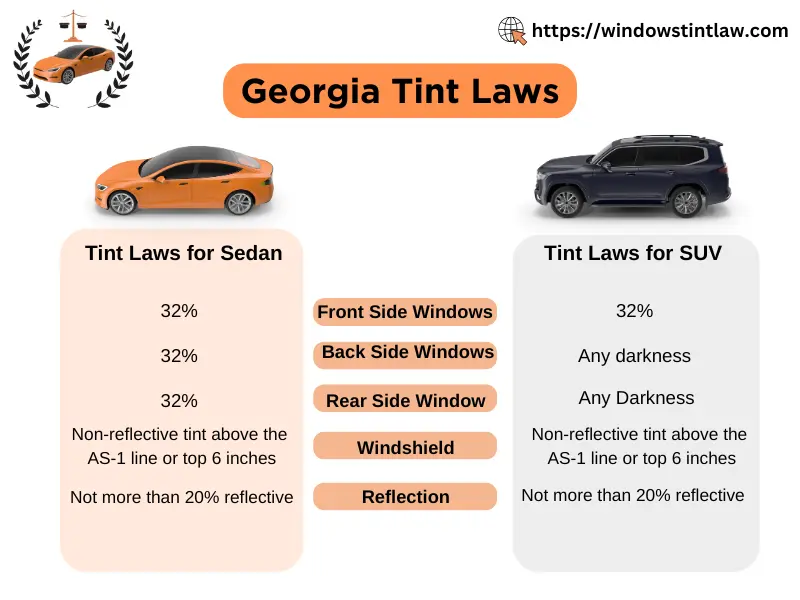Georgia tint laws were legislated in 2005 to ensure the safety of vehicle occupants on roads and highways.
Window Tinting rules of Georgia permits motorist to tint their vehicles with 32 percent VLT for the front side windows of Cars and SUVs. However, Non-reflective sun screening material can be applied to AS-1 line or top 6 inches of the front windshield. The glazing or tinting materials applied to vehicle windows must not reflect more than 20 percent light as compared to standard window with no covering installed.
Follow the below sections for detailed guide about the Window Tinting rules for vehicles operated and registered in Georgia.
Overview of Georgia Tint Laws
The below image shows the legal tint limits for Cars and SUVs operated in Georgia. Drivers must follow these limits to avoid tint tickets.

Darkest Legal Tint in Georgia
The darkest legal tint percentage for Sedan and SUVs or Trucks operated in Georgia are mentioned as below:
Legal Tint Darkness For Sedan or Cars
The tinting or glazing material applied to side windows and rear window must have a visible light transmission of 32 percent with a deviation of 3 percent allowed. However, the uppermost area front windshield known as AS-1 line can be covered with the non-reflective and transparent material which must not be in red or amber color.
| State | Front Side Windows | Back Side Windows | Rear Window | Windshield | Tint Reflection | Tint Colors |
| Georgia | 32% | 32% | 32% | Non-reflective tint above the AS1 line or top 6 inches of front windshield. | Not more than 20% reflective. | Red and Amber Tint colors are restricted on windshield. |
Legal Tint Darkness For SUV, Vans or Trucks
Front side windows of a truck or SUV can be covered with a tinting or sun screening material that must have a VLT of 32% with a variance of plus minus 3 percent. However, the back side windows and rear window can covered with tinting material of any darker tint shade. Also, The AS-1 line area of front windshield can be covered with a non-reflective transparent material that must not be red or amber in color.
| State | Front Side Windows | Back Side Windows | Rear Window | Windshield | Tint Reflection | Tint Colors |
| Georgia | 32% | Material with any VLT percentage allowed. | Material with any VLT percentage allowed. | Non reflective tint above the AS1 line or top 6 inches of front windshield. | Not more than 20% reflective. | Red and Amber Tint colors are restricted on windshield. |
Window Tint Reflection
Tinting or sun screening material applied to side windows, front windshield or rear window must not have solar reflectance of 20% or more. The same condition is applicable for Cars and SUV type vehicles.
Motorists are advised to install the appropriate tinting material type which should not reflect light to a large extent. As the reflective tinting materials produces glare due to sunlight which cause inconvenience for other drivers on the road.
Other Rules & Regulations
There are some other rules for vehicles with tinted windows:
- Dual Side Mirrors: Dual side mirrors are not conditionally required for vehicles with tinted windows.
- Restricted Tint Colors: Red and Amber tint colors are not allowed.
- Certificates: Window film manufacturers are not required to get the certificate of the legal tint they sell in the state.
- Stickers: Stickers or label to identify the legal tint is not required to display on vehicle windows.
Medical Exemption
The department of Public safety, upon receiving the application from a person which requires to get shielded from direct sun can get the medical exemption. The application for medical exemption in Georgia must be certified by the licensed Optometrist practicing in the state.
Finally, The tint waiver can be applied for a vehicle operated by a person with a medical condition or in which he is a habitual traveler.
Penalties for Violating Tint Laws
Any person who caught violating Georgia window tinting laws shall be guilty of misdemeanor and can be fined with a tint ticket of up to $1000. The cost of tint ticket could be $25-$100 for the first offense. However, second offenses may cost up to $200 for an illegal window tinting. Subsequent offenses can lead to higher amount of fines and person may go to jail. The prison period can be up to 12 months. If police officers suspect that illegal tint has been applied to a car, they can use an electronic device to evaluate the window tint.
Therefore, Motorists are advised to apply legal tint on their vehicles to avoid heavy fines and legal actions.
